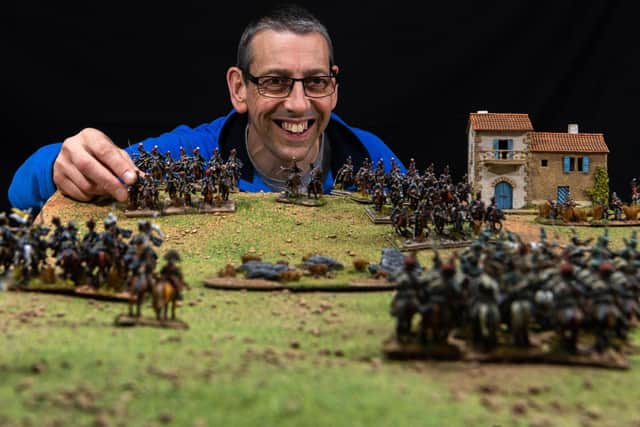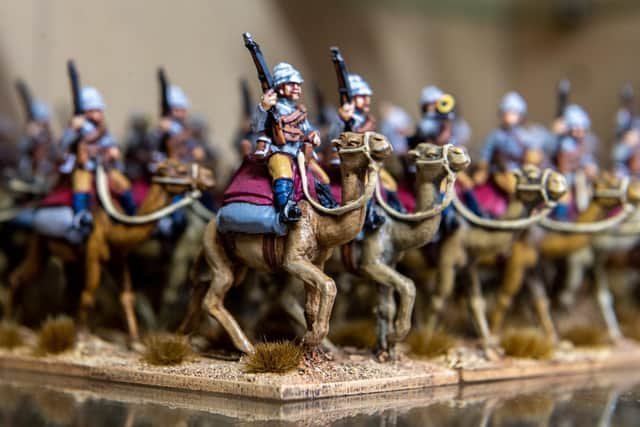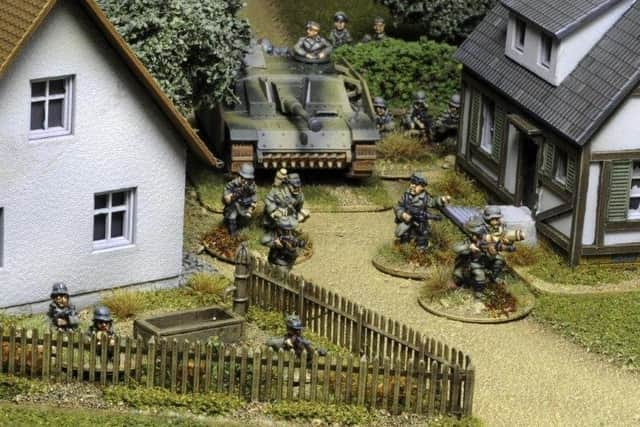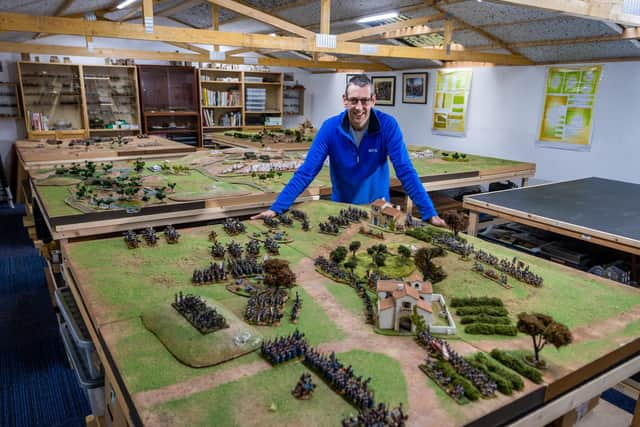Meet the tabletop wargamers whose hobby is enjoying an unexpected revival
In fact, he’s gone a little further and built what can best be described as a shrine to the miniature legions along with their accompanying cavalry, tank regiments and artillery.
From the outside, the wooden lodge next to Richard’s home a few miles from the centre of Bradford looks like it might contain a sauna or gym, but inside it is the ultimate boys’ own paradise where he – and a group of like-minded friends – recreate battles from the time of King Arthur through to the Cold War in perfect miniature.
Advertisement
Hide AdAdvertisement
Hide Ad“This has been a long-held dream,” says Richard, surveying the fruits of his labours. “I always wanted a dedicated space not only for me to wargame but where we could introduce it to others too. It’s one of those hobbies that never seems to have gone away.”


Richard’s ambition to run a series of wargame weekends throughout the year has inevitably been put on hold, but when normality returns he hopes to capitalise on the growing number of men who spent their teenage years rolling dice to determine the fate of Celtic raiders or Napoleonic soldiers and have now re-embraced the hobby in their middle age.
“I was 16 years old when I first became hooked,” he says. “I persuaded my parents to let me go to the Wargames Holiday Centre, near Filey. It was the first time I had been away on my own and it was quite magical.”
Run by Peter Gilder, widely acknowledged to be the grandmaster of tabletop wargaming, in the early days enthusiasts would be collected by minibus from York Station and for the following week hunker down in a 30ft “bunker” playing a series of battles from past conflicts.
Advertisement
Hide AdAdvertisement
Hide AdA master model painter and figure designer, Gilder was a bit of a hero for Richard and his own wargaming centre has been designed along much the same lines as the one in Filey, where racks of figures lined every available space.


“In a world in which so much is throwaway, there is something really appealing about a hobby where every playing piece is so lovingly crafted,” he says. “A lot of these sets are works of arts in their own right and when you see them set up for the opening of a game they look incredible.
“Also I think there is something quite therapeutic about playing a game over a series of days. Yes, of course there is luck involved, but wargaming is also about tactics; it requires a lot of thought.”
Depending on his mood, one day might see Richard embroiled in one of the most hotly contested battles of the Napoleonic Wars while on another his tiny Nato forces might be trying to hold off the Soviets.
Advertisement
Hide AdAdvertisement
Hide Ad“In more recent years there have been various computer versions of tabletop wargaming and I know some people love them, but I don’t think you can beat the real thing. Partly there’s the social interaction which you don’t get through a screen, but I also don’t think you get the same wow factor.


“When you’ve spent hours setting up a Napoleonic battle, there is a real sense of satisfaction seeing every piece in its proper place and no matter how good computer games get I don’t think that’s something they will ever be able to rival.”
Richard isn’t alone. Over the last few years board games – and wargaming in particular – have experienced something of a revival and the trend has been accentuated in recent months as more of us look back to childhood pursuits.
According to the market research group NPD, which measures trends across the global toy trade, sales of tabletop games rose by 20 per cent in 2016 and received a further boost last year with families looking for an alternative to yet another night in front of the TV.
Advertisement
Hide AdAdvertisement
Hide AdWhile classic board games like Monopoly, Scrabble and Cluedo were the top sellers, tabletop wargaming, along with role-playing games such as Dungeons and Dragons, has also benefited from the revival, which is being fuelled by our collective need for escapism.


“The hobby is thriving,” says a spokesman for the British Historical Games Society. “The rise in popularity is driven by many of the same social factors which are behind the resurgence of board gaming in general, but also in more recent years technical innovations in figure design and production techniques have really helped.
“There is a constantly expanding catalogues of figures covering every era, and every theatre of conflict and that means there is always something new to play.”
When it started 14 years ago Games Expo, which has a large wargaming presence, attracted a few hundred visitors. At the last live event in 2019 more than 25,000 passed through the doors of Birmingham’s NEC and having been forced to postpone last year’s event organisers expect an even higher attendance if June’s event goes ahead as planned.
Advertisement
Hide AdAdvertisement
Hide Ad“In 35 years this is without doubt the longest period I’ve gone without meeting up with friends for a wargaming session, but we have been able to play via Facebook,” says Steve Shann, who also makes a living painting miniatures for other people.
“There’s not the same sense of immediacy when you have to post a move and wait for the organiser to play it out and post a photograph of the end result, but it’s been the next best thing.”
Steve, who is a Franco Prussian War specialist, has converted the cellar of his Wakefield home into a model workshop and, while he admits that he never showed any particular artistic ability at school, he has since spent thousands of hours paintbrush in hand recreating the uniforms of countless fighting units.
“Honestly, I’d struggle to draw a straight line, but I guess I found my niche with these figures,” he says. “Some of them are incredibly intricate, but that’s the appeal.
Advertisement
Hide AdAdvertisement
Hide Ad“You tend to find that everyone who plays has their own particular favourite period and like much else in life I stumbled across mine by accident. Years ago when I’d come back to Yorkshire after a period of living abroad I went with my dad to Leeds University where he was studying at the time. I was killing time wandering around the library and came across this beautiful set of books on the Franco Prussian War.”
He became a member, took them out and the rest, he says, is quite literally history. “Much like any battle, wargaming is about tactics, but there is also an element of luck,” says Steve, who has recently written his own wargaming guide to the Second World War’s Battle of Seelow Heights.
“A few years ago now I did have a go at a computer version but it was weirdly anti-climatic. I’d been meaning to write my own game based around the three-day battle in 1945 which saw the Germans pitched against the Russians for about seven years and when lockdown happened I thought I might as well make the most of the time.
“You’ll only know how good it is when other people play it, but I’m really pleased with how it’s turned out.”
Advertisement
Hide AdAdvertisement
Hide AdWhen the current restrictions allow Steve to be reunited with his fellow wargamers they plan to stage the Battle of Borodino, the bloodiest conflict of the Napoleonic Wars in which 68,000 men lost their life in a single day.
“There are so many different battles and the variety I think is part of the appeal,” says Steve, who has just turned 60. “The only problem is we are not getting any younger. Everyone I play with is roughly the same age, but none of our sons have taken up the hobby.
"Maybe it will die out with us, but I’d like to think there is another younger generation who will get the same pleasure out of it as we do.”
For details of Richard’s wargaming weekends visit legendarywargames.com and to see more of Steve’s figure painting visit steve-nationsinarms.blogspot.com